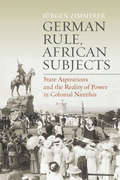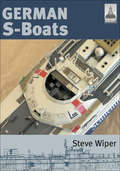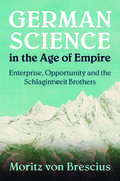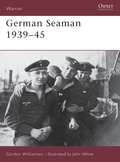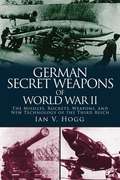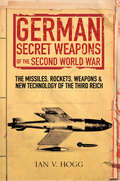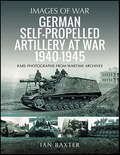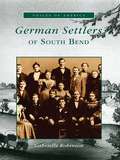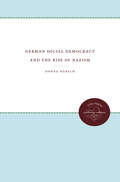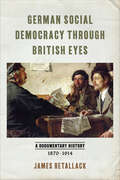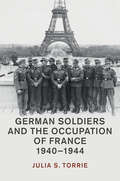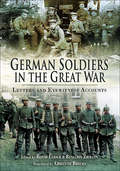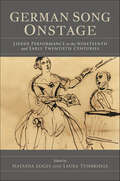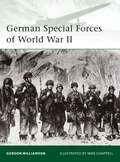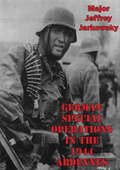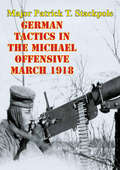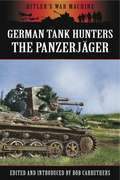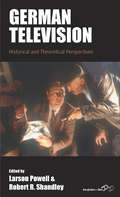- Table View
- List View
German Rule, African Subjects: State Aspirations and the Reality of Power in Colonial Namibia
by Jürgen ZimmererAlthough it lasted only thirty years, German colonial rule dramatically transformed South West Africa. The colonial government not only committed the first genocide of the twentieth century against the Herero and Nama, but in their efforts to establish a “model colony” and “racial state,” they brought about even more destructive and long-lasting consequences. In this now-classic study—available here for the first time in English—the author provides an indispensable account of Germany's colonial utopia in what is present-day Namibia, showing how the highly rationalized planning of Wilhelmine authorities ultimately failed even as it added to the profound immiseration of the African population.
German Rule, African Subjects: State Aspirations and the Reality of Power in Colonial Namibia
by Jürgen ZimmererAlthough it lasted only thirty years, German colonial rule dramatically transformed South West Africa. The colonial government not only committed the first genocide of the twentieth century against the Herero and Nama, but in their efforts to establish a “model colony” and “racial state,” they brought about even more destructive and long-lasting consequences. In this now-classic study—available here for the first time in English—the author provides an indispensable account of Germany's colonial utopia in what is present-day Namibia, showing how the highly rationalized planning of Wilhelmine authorities ultimately failed even as it added to the profound immiseration of the African population.
German S-Boats (ShipCraft)
by Steve WiperThe 'ShipCraft' series provides in-depth information about building and modifying model kits of famous warship types. Lavishly illustrated, each book takes the modeller through a brief history of the subject class, highlighting differences between sister-ships and changes in their appearance over their careers. This includes paint schemes and camouflage, featuring colour profiles and highly-detailed line drawings and scale plans. The modelling section reviews the strengths and weaknesses of available kits, lists commercial accessory sets for super-detailing of the ships, and provides hints on modifying and improving the basic kit. This is followed by an extensive photographic gallery of selected high-quality models in a variety of scales, and the book concludes with a section on research references—books, monographs, large-scale plans and relevant websites. The subject of this volume is the Second World War German Navy's motor torpedo boats called Schnellboote, known to the Allies as E-Boats. One of the most effective coastal attack craft of the time, the type was built in large numbers and constantly improved as the war progressed, giving many variants to interest modellers. With its unparalleled level of visual information—paint schemes, models, line drawings and photographs—it is simply the best reference for any modelmaker setting out to build one of these famous boats.
German S-Boats in Action in the Second World War
by Hans FrankA detailed narrative of S-boat, or schnellboot, actions during World War II in all the theatres where they were deployed. The author, describes, with the help of a multitude of maps and photographs, all the incidents that these 45-knot fast attack craft were involved in. The German motor torpedo boat (German: S-boot, English: E-boat) was a controversial subject in the pre-war period of German naval rearmament. As late as 1938, the Fleet Commander recommended that S-boot building be terminated on the grounds that the craft was merely a 'weapon of opportunity' without a defined role. This outlook changed dramatically after the first wartime successes. Soon the S-boot was required on all fronts, and the area of operations. In this volume the operational deployment of the S-Boot in these theatres is given comprehensive treatment for the first time, and not purely from the isolated viewpoint of S-Boot warfare, but as an integral part of the overall military objectives of the time. This study of the effectiveness of the S-Boot, its successes and failures, is based on war diary entries and previously unseen original sources. It is a first-class account of this German naval arm in which survived to be the last class of German surface warship still carrying the offensive to the enemy.
German Scholars And Ethnic Cleansing, 19191945
by Ingo Haar Michael FahlbuschRecently, there has been a major shift in the focus of historical research on World War II towards the study of the involvements of scholars and academic institutions in the crimes of the Third Reich. The roots of this involvement go back to the 1920s. At that time right-wing scholars participated in the movement to revise the Versailles Treaty and to create a new German national identity. The contribution of geopolitics to this development is notorious. But there were also the disciplines of history, geography, ethnography, art history, archeology, sociology, and demography that devised a new nationalist ideology and propaganda. Its scholars established an extensive network of personal and institutional contacts. This volume deals with these scholars and their agendas. They provided the Nazi regime with ideas of territorial expansion, colonial exploitation and racist exclusion culminating in the Holocaust. Apart from developing ideas and concepts, scholars also actively worked in the SS and Wehrmacht when Hitler began to implement its criminal policies in World War II. This collection of original essays, written by the foremost European scholars in this field, describes key figures and key programs supporting the expansion and exploitation of the Third Reich. In particular, they analyze the historical, geographic, ethnographical and ethno-political ideas behind the ethnic cleansing and looting of cultural treasures.
German Science in the Age of Empire: Enterprise, Opportunity and the Schlagintweit Brothers (Science in History)
by Moritz von BresciusThis seminal study explores the national, imperial and indigenous interests at stake in a major survey expedition undertaken by the German Schlagintweit brothers, while in the employ of the East India Company, through South and Central Asia in the 1850s. It argues that German scientists, lacking in this period a formal empire of their own, seized the opportunity presented by other imperial systems to observe, record, collect and loot manuscripts, maps, and museological artefacts that shaped European understandings of the East. Drawing on archival research in three continents, von Brescius vividly explores the dynamics and conflicts of transcultural exploration beyond colonial frontiers in Asia. Analysing the contested careers of these imperial outsiders, he reveals significant changes in the culture of gentlemanly science, the violent negotiation of scientific authority in a transnational arena, and the transition from Humboldtian enquiry to a new disciplinary order. This book offers a new understanding of German science and its role in shaping foreign empires, and provides a revisionist account of the questions of authority and of authenticity in reportage from distant sites.
German Seaman 1939-45
by John White Gordon WilliamsonWhen re-armament came after World War I, the German Navy was forced to build anew, so the Reichsmarine and its successor, the Kriegsmarine, found itself in possession of some of the most modern, powerful and technically advanced vessels in the world. Germany was very selective in picking her sailors and the quality of manpower skill levels was thus very high. This book charts the recruitment, training, service conditions and combat experiences of a typical World War II German sailor, focusing on the main branches of the Navy, as well as the last ditch combat units thrown into action as infantry in the final days of the war.
German Secret Weapons of World War II: The Missiles, Rockets, Weapons, and New Technology of the Third Reich
by Ian V. HoggHitler’s regime was notorious for its many experiments and its various secret ploys, weapons, and technological developments. But typically, the term "secret German weapons” only turns up images of the V-1 and V-2 missiles that played a part in bombing London in 1944. But truth be told, there were many more unheard of weapons behind the Third Reich. Many of these weapons have been unknown to the general public. Here, Ian V. Hogg, one of the world’s leading experts on weaponry, reveals the sheer magnitude of Hitler’s secret weapon projects, from the V-3 and the V-4 missiles, to the Schmetterling, to the German nuclear bomb, to the question of nuclear war and more. This detailed account of the myths surrounding secret German weapons examines the various fields the Germans concentrated on during their weapon development process and discusses difficulties that arrived in the process and how, in many cases, the ideas were exploited by other nations.German Secret Weapons of the Second World War draws comparisons between similar Allied projects and narrates the deeper purpose behind many of these projects. Many of these developments were not completed before the end of the war, but have created a solid foundation for many of today’s great military developments. Skyhorse Publishing, as well as our Arcade imprint, are proud to publish a broad range of books for readers interested in history—books about World War II, the Third Reich, Hitler and his henchmen, the JFK assassination, conspiracies, the American Civil War, the American Revolution, gladiators, Vikings, ancient Rome, medieval times, the old West, and much more. While not every title we publish becomes a New York Times bestseller or a national bestseller, we are committed to books on subjects that are sometimes overlooked and to authors whose work might not otherwise find a home.
German Secret Weapons of the Second World War: The Missiles, Rockets, Weapons & New Technology of the Third Reich
by Ian V. Hogg&“A comprehensive, highly detailed study [that] displays a stunning wealth of technical knowledge . . . a brisk and understandable narrative.&” —HistoryNet The phrase &“German secret weapons&” immediately conjures up images of the V-1 and V-2 missiles that bombarded London in 1944. But what of the V-3 and V-4? What of Schmetterling, the Rochling shell, the Kurt bomb, the Hs293? These, and many other devices, were all part of the German secret armory, but are relatively unknown except to a handful of specialists. What of the German nuclear bomb? And the question of chemical warfare? The sheer magnitude of the secret weapon projects of the Third Reich is revealed in this comprehensive study written by one of the world&’s great experts on weaponry. The book explores the various fields in which the Germans concentrated their weapon development and discusses the multiplicity of ideas, the difficulties, and, in several cases, how these ideas were subsequently exploited by the victors. Although much of the German wartime development was not completed before the war&’s end, it nevertheless provided a foundation for a great deal of the munitions development that has since taken place. Comparisons with Allied projects are also drawn. This book explodes some of the myths surrounding Hitler&’s secret weapons to reveal a truth all the stranger for being fact. Includes photographs and line drawings
German Security and Police Soldier 1939-45
by Gordon Williamson Velimir VuksicThe security units of the Third Reich were many and diverse, yet often an oversimplified view is projected of these organisations. This title provides a detailed and informed picture of the variety of operations and duties, as well as the motivation and behaviour of the men involved. It charts the experiences of typical World War II security forces and police soldiers - from the routine of military traffic duty, to combating partisans and resistance fighters. It covers the military police of the Armed Forces proper and the Waffen-SS, the combat units of the German State Police, the SD Sicherheitsdienst, the Schutzmannschaft' units, and the extreme and dreaded anti-partisan units 'Dirlewanger' and 'Kaminski'.
German Self-propelled Artillery at War 1940–1945
by Ian Baxter“Easily recommended as an introduction to German self-propelled artillery of WWII, or as a modelling reference.” — Armorama Despite the German Panzerwaffe’s ability to engage its foes rapidly with concentrated force, additional fire power was often required to break through enemy lines. Initially this was with towed artillery but, as the war developed, converting tanks into fast-moving self-propelled artillery carrying vehicles proved far more effective. As a result a number of weapon systems came into service including the Pz.Kpfw.I and II. Other conversions followed including the Pz.Kpfw.II Wespe with its 10.5cm gun, the Pz.Kpfw.III/IV Hummel armed with a 15cm howitzer, the Sturmpanzer Brummbar with its powerful 15cm gun and the Grille series based on the Czech Pz.Kpfw 38(t) tank chassis. These and other armored vehicles were capable of providing both close firesupport for infantry and acting as anti-tank weapons. This highly illustrated book describes the key role played by German self-propelled artillery from its introduction in 1940 in France, to North Africa, Italy, Russia and North-West Europe. It analyzes the development of the numerous variants that came into service as these formidable weapon systems were adapted and up-gunned to face the ever-increasing enemy threat. With rare and often published photographs this book provides a unique insight into German self-propelled artillery from its early triumphant war years to final defeat in 1945.
German Settlers of South Bend
by Gabrielle RobinsonThe story of the first German immigrants to northern Indiana is the story of the beginnings of South Bend. The predominant immigrant group from the 1840s to the 1870s, the Germans helped build South Bend from an isolated trading post into a thriving industrial city. They also played a key role in transforming the surrounding wilderness into rich and fertile farmland.Using first-hand personal accounts and public documents, German Settlers of South Bend illustrates the lives of these pioneer immigrants and their growing city. The material has been collected from a large number of sources on both sides of the Atlantic, including more than 200 German letters from the 1840s to the 1870s that provide glimpses into the day-to-day lives of these early settlers and their families back in Germany. Descendants of immigrants from all over the United States and Germany have come forward with genealogies, stories, and pictures, providing a far-reaching portrait of the times.
German Social Democracy and the Rise of Nazism
by Donna HarschGerman Social Democracy and the Rise of Nazism explores the failure of Germany's largest political party to stave off the Nazi threat to the Weimar republic. In 1928 members of the Social Democratic Party (SPD) were elected to the chancellorship and thousands of state and municipal offices. But despite the party's apparent strengths, in 1933 Social Democracy succumbed to Nazi power without a fight. Previous scholarship has blamed this reversal of fortune on bureaucratic paralysis, but in this revisionist evaluation, Donna Harsch argues that the party's internal dynamics immobilized the SPD. Harsch looks closely at Social Democratic ideology, structure, and political culture, examining how each impinged upon the party's response to economic disaster, parliamentary crisis, and the Nazis. She considers political and organizational interplay within the SPD as well as interaction between the party, the Socialist trade unions, and the republican defense league. Conceding that lethargy and conservatism hampered the SPD, Harsch focuses on strikingly inventive ideas put forward by various Social Democrats to address the republic's crisis. She shows how the unresolved competition among these proposals blocked innovations that might have thwarted Nazism.Originally published in 1993.A UNC Press Enduring Edition -- UNC Press Enduring Editions use the latest in digital technology to make available again books from our distinguished backlist that were previously out of print. These editions are published unaltered from the original, and are presented in affordable paperback formats, bringing readers both historical and cultural value.
German Social Democracy through British Eyes: A Documentary History, 1870–1914
by James RetallackOn the eve of the First World War, the German Social Democratic Party (SPD) was the largest and most powerful socialist party in the world. German Social Democracy through British Eyes examines the SPD’s rise using British diplomatic reports from Saxony, the third-largest federal state in Imperial Germany and the cradle of the socialist movement in that country. Rather than focusing on the Anglo-German antagonism leading to the First World War, the book peers into the everyday struggles of German workers to build a political movement and emancipate themselves from the worst features of a modern capitalist system: exploitation, poverty, and injustice. The archival documents, most of which have never been published before, raise the question of how people from one nation view people from another. The documents also illuminate political systems, election practices, and anti-democratic strategies at the local and regional levels, allowing readers to test hypotheses derived only from national-level studies. This collection of primary sources shows why, despite the inhospitable environment of German authoritarianism, Saxony and Germany were among the most important incubators of socialism.
German Soldiers and the Occupation of France, 1940–1944 (Studies in the Social and Cultural History of Modern Warfare)
by Julia S. TorrieFrom 1940 to 1944, German soldiers not only fought in and ruled over France, but also lived their lives there. While the combat experiences of German soldiers are relatively well-documented, as are the everyday lives of the occupied French population, we know much less about occupiers' daily activities beyond combat, especially when it comes to men who were not top-level administrators. Using letters, photographs, and tour guides, alongside official sources, Julia S. Torrie reveals how ground-level occupiers understood their role, and how their needs and desires shaped policy and practices. At the same time as soldiers were told to dominate and control France, they were also encouraged to sight-see, to photograph and to 'consume' the country, leading to a familiarity that limited violence rather than inciting it. The lives of these ordinary soldiers offer new insights into the occupation of France, the history of Nazism and the Second World War.
German Soldiers in Colonial India (Warfare, Society and Culture #10)
by Chen Tzoref-AshkenaziTzoref-Ashkenazi presents a detailed study of two German regiments which served in India under the British between 1782 and 1791. He asks if the Germans identified with the goals of the British colonial power, how they felt about local people and whether they adopted the colonial ideologies of their British employers.
German Soldiers in the Great War: Letters and Eyewitness Accounts
by Jay Winter Benjamin Ziemann Bernd UlrichThe first English translation of writings that capture the lives and thoughts of German soldiers fighting in the trenches and on the battlefields of WWI. German Soldiers in the Great War is a vivid selection of firsthand accounts and other wartime documents that shed new light on the experiences of German frontline soldiers during the First World War. It reveals in authentic detail the perceptions and emotions of ordinary soldiers that have been covered up by the smokescreen of official military propaganda about “heroism” and “patriotic sacrifice.” In this essential collection of wartime correspondence, editors Benjamin Ziemann and Bernd Ulrich have gathered more than two hundred mostly archival documents, including letters, military dispatches and orders, extracts from diaries, newspaper articles and booklets, medical reports and photographs. This fascinating primary source material provides the first comprehensive insight into the German frontline experiences of the Great War, available in English for the first time in a translation by Christine Brocks.
German Song Onstage: Lieder Performance in the Nineteenth and Early Twentieth Centuries
by Natasha Loges and Laura TunbridgeA singer in an evening dress, a grand piano. A modest-sized audience, mostly well-dressed and silver-haired, equipped with translation booklets. A program consisting entirely of songs by one or two composers. This is the way of the Lieder recital these days. While it might seem that this style of performance is a long-standing tradition, German Song Onstage demonstrates that it is not. For much of the 19th century, the songs of Beethoven, Schubert, Schumann, and Brahms were heard in the home, salon, and, no less significantly, on the concert platform alongside orchestral and choral works. A dedicated program was rare, a dedicated audience even more so. The Lied was a genre with both more private and more public associations than is commonly recalled. The contributors to this volume explore a broad range of venues, singers, and audiences in distinct places and time periods—including the United States, the United Kingdom, Russia, and Germany—from the mid-19th century through the early 20th century. These historical case studies are set alongside reflections from a selection of today's leading musicians, offering insights on current Lied practices that will inform future generations of performers, scholars, and connoisseurs. Together these case studies unsettle narrow and elitist assumptions about what it meant and still means to present German song onstage by providing a transnational picture of historical Lieder performance, and opening up discussions about the relationship between history and performance today.
German Special Forces of World War II
by Mike Chappell Gordon WilliamsonOsprey's study of the troops that made up Germany's elite special forces of World War II (1939-1945). Such forces included the legenday Skorzeny Commandos who carried out such audacious tasks as the glider-borne rescue of Mussolini, and the kidnapping of the son of the Hungarian regent, Admiral Horthy. This book also includes details of lesser-known units such as the Brandenburgers, who operated behind enemy lines in captured uniforms, and the Kleinkampfverbände who were the forerunners of modern-day naval combat troops like the US Navy SEALs. Complete with uniform and kit detail together with action accounts of many of these daring operations, this book is a must-have for any special forces enthusiast.
German Special Operations In The 1944 Ardennes Offensive
by Major Jeffrey JarkowskyThis study is a historical analysis of the German special operations conducted in support of their overall Ardennes offensive. It focuses on the two major special operations of the German offensive, Operations "Greif" and "Stoesser." Operation Greif was the German attempt to infiltrate a commando unit behind American lines disguised as American soldiers. Operation Stoesser, the last German airborne operation of the war, was designed to secure a key cross-roads behind American lines. These special operations failed because of faulty planning, inadequate preparation, and a lack of coordination between the special and conventional forces. These problems, exacerbated by a lack of preparation time, resulted in a pair of ad-hoc units that were unable to accomplish their primary missions, although the operations were characterized by boldness, initiative, and improvisation. This study also examines the strategic setting, planning, preparations, and conduct of these operations, as well as their impact on the overall campaign. This study also examines the key lessons-learned that can be derived from both operations. Lastly, the study explores the implications of these lessons for the U.S. military of today.
German Tactics In The Michael Offensive March 1918
by Major Patrick T. StackpoleThis study investigates the German spring offensive of 1918 to determine how the Germans achieved tactical success, yet failed to reach their strategic objective. The study covers the development of new German infantry tactics during limited offensive operations and conduct of the "elastic defense" on the western front It investigates the development of artillery tactics on the eastern front, and the incorporation of these artillery and infantry tactics into larger scale offensives at Caporetto. The study describes the preparation of both the infantry and artillery units for the "Michael" offensive. The relationship between the infantry and artillery tactics combined with the British defense is the key to determine the causes for success and failure.The German tactical system used in "Operation Michael" was a brilliant adaptation to the lethality of the World War I battlefield. The German techniques were superb tools for conducting a breakthrough of a defensive zone. However, the lack of German mobility following the breakthrough foiled the German strategic goal to envelop the British Army.German techniques and lessons learned in this offensive have direct application to U.S. Army infiltration doctrine.
German Tank Hunters: The Panzerjäger (Hitler's War Machine)
by Bob CarruthersThis unique collection of contemporary combat accounts provides a primary source insight into the reality of anti-tank warfare on the Eastern Front. Both armoured and infantry based operations are considered.This book is part of the 'Hitler's War Machine' series, a new military history range compiled and edited by Emmy Award winning author and historian Bob Carruthers. The series draws on primary sources and contemporary documents to provide a new insight into the true nature of Hitler's Wehrmacht.The series consultant is David Mcwhinnie creator of the award winning PBS series 'Battlefield'.
German Television: Historical and Theoretical Perspectives
by Larson Powell Robert ShandleyLong overlooked by scholars and critics, the history and aesthetics of German television have only recently begun to attract serious, sustained attention, and then largely within Germany. This ambitious volume, the first in English on the subject, provides a much-needed corrective in the form of penetrating essays on the distinctive theories, practices, and social-historical contexts that have defined television in Germany. Encompassing developments from the dawn of the medium through the Cold War and post-reunification, this is an essential introduction to a rich and varied media tradition.
German U-Boat Losses During World War II: Details of Destruction
by Axel NiestléA deep dive into the fate of German submarines lost during the Second World War. &“This has to be the best reference you can find on the subject.&”—Military Modelling No other publication on this subject comes even close to including the amount of detail provided in this book. An introduction both summarizes previous works on the subject and describes the difficulties of obtaining and verifying information from either the Germans or the Allies on U-boat losses. The main part of the book lists by hull number each U-boat&’s date of commissioning, its commanding officer, and the date and port of departure for its last patrol. It also gives the date, position, and cause of loss of each submarine, with complete details on Allied units involved in the sinking, the names and ranks of their commanding officers and pilots, and the number of crew killed or rescued. An appendix neatly summarizes data on the disposition of surviving U-boats at the end of the war and provides valuable statistical data on German U-boat losses. &“Highly recommended for every serious scholar of the Atlantic war, and every library in naval history and the history of the Second World War.&”—The Mariner&’s Mirror &“The level of detail is quite impressive and this edition is the result of 16 years of further research since the first edition . . . If you are seeking data on the fate of U-Boats then this book should be your &‘first place of call&’—no other book has such detailed data.&”—Military Archive Research
German Unification
by Robert R. Shandley Peter C. CaldwellIt is easy in retrospect to ascribe inevitability to vast historical events like the East German Revolution and the unification of Germany that followed. But in fact, such events are not inevitable; they are the product of decisions made at the moment, when the outcomes of a process were not yet clear. Under severe time constraints dictated by an opening in international relations connected to Gorbachev, and ongoing upheaval in East German politics that put the state's existence into question, and an economic collapse in East Germany, policymakers sought not only the limited knowledge of the future of the actors involved but also the long-term consequences of their actions.
